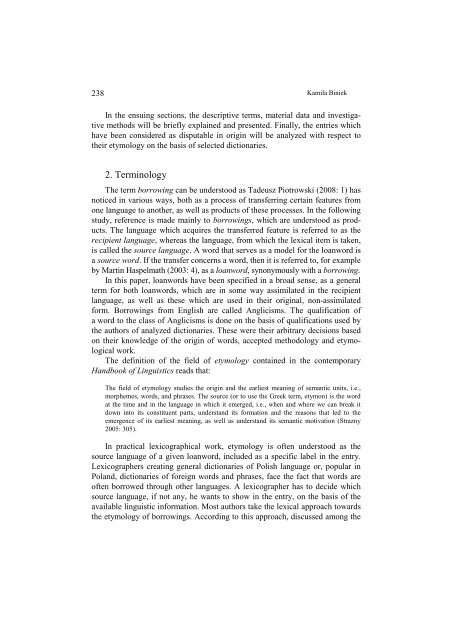s - Wyższa SzkoÅa Filologiczna we WrocÅawiu
s - Wyższa SzkoÅa Filologiczna we WrocÅawiu
s - Wyższa SzkoÅa Filologiczna we WrocÅawiu
Create successful ePaper yourself
Turn your PDF publications into a flip-book with our unique Google optimized e-Paper software.
238<br />
Kamila Biniek<br />
In the ensuing sections, the descriptive terms, material data and investigative<br />
methods will be briefly explained and presented. Finally, the entries which<br />
have been considered as disputable in origin will be analyzed with respect to<br />
their etymology on the basis of selected dictionaries.<br />
2. Terminology<br />
The term borrowing can be understood as Tadeusz Piotrowski (2008: 1) has<br />
noticed in various ways, both as a process of transferring certain features from<br />
one language to another, as <strong>we</strong>ll as products of these processes. In the following<br />
study, reference is made mainly to borrowings, which are understood as products.<br />
The language which acquires the transferred feature is referred to as the<br />
recipient language, whereas the language, from which the lexical item is taken,<br />
is called the source language. A word that serves as a model for the loanword is<br />
a source word. If the transfer concerns a word, then it is referred to, for example<br />
by Martin Haspelmath (2003: 4), as a loanword, synonymously with a borrowing.<br />
In this paper, loanwords have been specified in a broad sense, as a general<br />
term for both loanwords, which are in some way assimilated in the recipient<br />
language, as <strong>we</strong>ll as these which are used in their original, non-assimilated<br />
form. Borrowings from English are called Anglicisms. The qualification of<br />
a word to the class of Anglicisms is done on the basis of qualifications used by<br />
the authors of analyzed dictionaries. These <strong>we</strong>re their arbitrary decisions based<br />
on their knowledge of the origin of words, accepted methodology and etymological<br />
work.<br />
The definition of the field of etymology contained in the contemporary<br />
Handbook of Linguistics reads that:<br />
The field of etymology studies the origin and the earliest meaning of semantic units, i.e.,<br />
morphemes, words, and phrases. The source (or to use the Greek term, etymon) is the word<br />
at the time and in the language in which it emerged, i.e., when and where <strong>we</strong> can break it<br />
down into its constituent parts, understand its formation and the reasons that led to the<br />
emergence of its earliest meaning, as <strong>we</strong>ll as understand its semantic motivation (Strazny<br />
2005: 305).<br />
In practical lexicographical work, etymology is often understood as the<br />
source language of a given loanword, included as a specific label in the entry.<br />
Lexicographers creating general dictionaries of Polish language or, popular in<br />
Poland, dictionaries of foreign words and phrases, face the fact that words are<br />
often borro<strong>we</strong>d through other languages. A lexicographer has to decide which<br />
source language, if not any, he wants to show in the entry, on the basis of the<br />
available linguistic information. Most authors take the lexical approach towards<br />
the etymology of borrowings. According to this approach, discussed among the
















